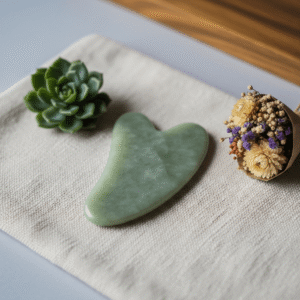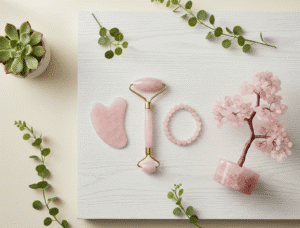Did you know, Why use gua sha stomach? What are the benefits? Today, we’ll explain in detail the benefits of stomach gua sha and how to use it. And what material is more suitable for stomach gua sha, stainless steel?
- Benefits about Gua Sha Stomach
- How To Use Gua Sha on Stomach?
- Which Materials Are Better About Gua Sha Stomach?
Benefits about Gua Sha Stomach

It is believed that Gua Sha, if performed correctly by a trained practitioner, can provide a variety of potential benefits to the stomach area:
- Pain Relief: Gua Sha can help relieve stomach pain and discomfort, especially those caused by muscle tension or poor blood circulation. By gua shathe skin, you can increase blood flow and relieve minor pain.
- Digestive Health: Some practitioners claim that gua sha on the stomach can aid digestion by stimulating the movement of abdominal Qi (energy) and blood. Improved blood circulation may help with a variety of digestive issues.
- Reduce stress: The gentle gua shamotion of Gua Sha has a relaxing effect, helping to reduce stress and promote a sense of well-being. Relieving stress can indirectly benefit stomach health, as stress is often linked to digestive issues.
- Detoxification: Chinese medicine believes that gua shacan help eliminate stagnant Qi and toxins from the body. By stimulating the skin and subcutaneous tissue, it is thought to promote the body’s natural detoxification process.
- Improving blood circulation: Gua Sha is believed to improve blood circulation in the treated area. Better circulation means tissues receive more oxygen and nutrients, which can promote healing and overall health.
It’s worth noting that while these benefits are often cited anecdotally, scientific evidence supporting the specific effects of gua sha on the stomach area is limited. Additionally, individual reactions to gua sha may vary and may not be suitable for everyone, especially those with certain medical conditions or sensitive skin.
How To Use Gua Sha on Stomach?

Using gua sha on the abdominal area requires more attention than on other parts of the body. Because the internal organs of the human body are located under the abdominal area, using Gua Sha in this location can easily have a direct impact on our organs. Gua Sha on the abdominal area involves gentle gua sha movements with a gua sha tool. Here’s a step-by-step guide on how to use Gua Sha on your abdomen:
1. Preparation stage:
- Cleaning: Wash your hands and stomach thoroughly to ensure cleanliness.
- Apply oil or lotion: Apply a small amount of oil or lotion to the stomach area. This helps the gua sha tool glide smoothly over the skin, reducing the risk of irritation.
2. Stomach gua sha technique:
- Hold the Gua Sha tool: Hold the Gua Sha tool with its curved side against the skin. The tool should be held at an angle of 15-45 degrees to the skin.
- Start gently: Start with gentle pressure. The pressure should be strong enough to create slight redness (called petechiae) on the skin, but not so hard that it causes pain or bruising.
- gua sha action: Use this tool to scrape the skin in one direction. Traditionally, Gua Sha follows the natural flow of lymph and blood circulation in a downward motion. Avoid scratching back and forth as this can cause skin irritation.
- Follow a pattern: You can follow a specific pattern, such as long strokes along the abdomen, covering the entire stomach area. Use smooth, continuous movements.
- Adjust pressure: Adjust the pressure according to your comfort level. If you feel pain or discomfort, relieve pressure immediately.
- Be aware of sensitivity: The abdomen can be a sensitive area. Use special caution around bony areas and sensitive skin.
- Duration: Gua Sha sessions usually last 5-10 minutes. Don’t overdo it, especially if you’re new.
3. Gua Sha aftercare:
- Clean again: After gua sha, clean the skin to remove oil or lotion residue.
- Moisturize: Apply a mild, non-irritating moisturizer to keep your skin hydrated.
- Rest: Allow your body to rest immediately after training and avoid any strenuous activity.
4. Precautions for gua sha the stomach:
- Speak to a Professional: If you are new to Gua Sha or have specific health concerns, consider consulting a trained Gua Sha therapist or healthcare professional for guidance.
- Avoid skin damage: Do not perform gua sha on areas with cuts, wounds or irritated skin.
- Personal sensitivity: Pay attention to your body’s reactions. If you experience excessive pain, discomfort, or unusual reactions, discontinue Gua Sha treatment immediately.
Always remember to be careful and respect your body’s limits when gua sha. If you are unsure or have any health concerns, please consult a medical professional.
Which Materials Are Better About Gua Sha Stomach?

The choice of gua sha tool material, whether stainless steel or other materials such as jade, rose quartz, buffalo horn or resin, depends on personal preference and needs. Each material has its own unique properties, and what may be considered “better” may vary from person to person. Here are some factors to consider when deciding on the material of a gua sha tool for your abdomen:
- Durability: Stainless steel is extremely durable and resistant to wear and tear, making it a long-lasting choice. If you are looking for a tool that can withstand heavy use, stainless steel may be a suitable choice.
- Hygiene: Stainless steel is non-porous, easy to clean, and can be effectively disinfected. This makes it a hygienic option, especially if the tool is intended to be used in a variety of people or professional settings.
- Temperature sensitivity: Stainless steel can quickly adjust the body temperature, providing a comfortable experience during use. Some people find the cool touch of stainless steel soothing, especially to reduce inflammation or discomfort.
- Multiple edges: Stainless steel gua sha tools come in various shapes and different edges and can be used on different parts of the body. A variety of edges provide a customized experience to meet the specific needs of the stomach area.
- Professional use: Stainless steel gua sha tools are commonly used in professional settings due to their durability and ease of sterilization. If you are a practitioner or plan to use the tool professionally, stainless steel may be the first choice.
However, it’s worth noting that other materials such as jade, rose quartz, and buffalo horn also have their benefits. For example:
- Jade gua sha: Considered to have healing properties and is gentle on the skin, suitable for a more delicate touch.
- Rose Quartz gua sha: Known as the love stone, it is believed to promote healing and relaxation. It has a smooth texture that provides a calming experience.
- Buffalo horn gua sha: Traditionally used in Gua Sha therapy, it is known for promoting blood circulation and is suitable for medium pressure.
- Resin gua sha: Lightweight, affordable and easy to handle. Resin gua sha tools are often chosen for their affordability.
Ultimately, the “best” material depends on your personal preference, budget, and the specific results you want to achieve. Some people prefer the energetic properties associated with certain crystals, while others prioritize durability and ease of maintenance. It is recommended to choose reputable and high-quality tools, regardless of material, to ensure safety and effectiveness during use.






